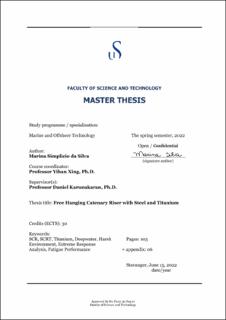| dc.description.abstract | Deepwater developments are becoming increasingly common in several parts of the world. Although the technological advances have grown exponentially since the first development in such great depth, challenges are still faced regarding the harsh environmental conditions. Considering that, the riser system is a critical part of the subsea architecture.
The Steel Catenary Riser (SCR) is usually the preferred option for deep and ultra-deep waters when its feasibility is ensured. However, this type of riser is very sensitive to the host platform's large motions due to the harsh environment. The large motion has the downward velocity at the hang-off point as a critical component, which can induce high levels of fatigue in that location and at the touchdown point (TDP). Thus, risers are usually designed with a flex joint on their top end, reducing or eliminating the fatigue issues in this area. For the TDP, other alternatives have been studied.
An alternative that has been considered is the implementation of a titanium section on the touchdown area (TDA) of an SCR, which feasibility in a deepwater and harsh environment is the focus of this work. A comparison with a conventional SCR is made in order to evaluate how the titanium affects the response on the TDA.
Results of the strength analyses showed that the SCR is unsuitable when the downward velocity is 3.8 m/s. By implementing the titanium section, which material has higher yield strength, the riser can cope with that downward velocity. The fatigue performance of the risers is checked considering the wave-induced fatigue. The conventional SCR demonstrates to have high fatigue damage, resulting in only 3.5 years on the TDP, which can be explained by its results on the strength analysis. On the other hand, the SCR with a titanium section has a fatigue life of over 20,000 years at the TDP, demonstrating it can improve the results significantly. Sensitivity studies are presented and explain how the riser with titanium is affected by changes in the section length, wall and coating thicknesses, and hang-off angle.
Overall, this thesis shows the feasibility of an SCR with a titanium section on the TDA when applied on a spread moored FPSO in deepwater and harsh environmental conditions.
Keywords: Deep water, SCR, SCR with titanium section, Extreme Response Analysis | |
